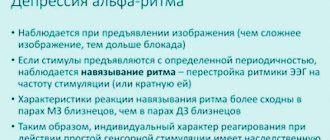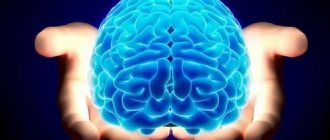The development of depressive states is accompanied by disturbances in the structure of all frequency ranges of the EEG. To a greater extent, these changes relate to the main EEG rhythm - the alpha rhythm [1, 5, 7, 10, 11, 18-20, 23].
Alpha rhythm - rhythmic oscillations with a frequency of 8-14 Hz and an average amplitude of 30-70 μV are recorded mainly in the occipital regions with the eyes closed in a state of quiet wakefulness and the maximum possible muscle relaxation. The rhythm is blocked by light stimulation, concentration and mental stress [2, 6, 9, 14, 15]. According to modern concepts, the generation of the alpha rhythm is associated with the reverberation of impulse activity along the intercortical and thalamo-cortical neural networks, and its severity determines the synchronization of the functional activity of various brain systems and, in particular, determines the connection of the information received from the afferent system of the body to the mechanisms of RAM, regulating adaptation processes. The alpha range in depression can significantly increase or decrease, and the spatial distribution of the rhythm also changes [3, 4, 16, 17]. Changes in alpha activity in depression depend on the clinical picture of the disease. Thus, an increase in the alpha rhythm index is characteristic of patients with “major depression,” and its decrease is characteristic of a desynchronized type of EEG in dysthymic disorders [24]. A number of researchers associate the peculiarities of changes in alpha activity with the dominance of melancholy, anxious or apathetic affect [8, 12, 13], thereby confirming the generally accepted position about the connection between the EEG structure and the functional activity of cortical zones. Since the clinical picture of depression changes throughout the day, the characteristics of the alpha rhythm in patients cannot remain unchanged. However, this question requires clarification.
The purpose of this work was to identify the characteristics of EEG alpha activity in the morning and evening hours in patients with endogenous depression.
Material and methods
18 patients with endogenous depression were examined. The diagnosis of the disease according to ICD-10 was determined by categories F31.3, F31.4, F32.0, F32.1, F32.2, F33.0, F33.1 and F33.2. Among the patients there were 9 women and 9 men aged from 24 to 52 years (average - 31.2±2.4 years). The duration of the disease ranged from 2 to 10 years (average 7.8±1.7 years).
In 9 patients, the type of disease was classified as recurrent depressive, in 9 - as bipolar. The number of affective phases experienced, including the last one, ranged from 2 to 10 (average 4.1±1.3).
The structure of the depressive state during the examination period was dominated by melancholy, anxious and, less often, apathetic affects. In the overwhelming majority of cases, there was a combination of basic elementary affects with the dominance of one of them. The severity of depression on the Hamilton scale (HAM-D) was 19-23 points [22].
The study was conducted when patients were admitted to the hospital in the spring.
Using the lateral traits questionnaire [21], right-handers were selected for the group of subjects.
The EEG was recorded using a hardware-software complex for topographic mapping of electrical activity of the brain NEURO-KM (Russia) with a bandwidth from 0 to 40 Hz and a time constant of 0.3 s. EEG recordings were carried out monopolarly from symmetrical frontal (F3, F4), central (C3, C4), parietal (P3, P4), occipital (O1, O2), anterior temporal (F7, F8), middle temporal (T3, T4) and posterior temporal ( T5, T6) cortical zones (scheme 10-20%, even channels are leads from the cortical zones of the right hemisphere, odd ones - from the left). Integrated ear clips served as the reference electrode. The characteristics and topographic distribution of EEG rhythms were determined using spectral analysis of the EEG using the fast Fourier transform method with averaging of at least 30 epochs of 2 seconds each, followed by mapping using the BRAINSYS system (Russia). Spectral and coherence EEG analyzes were performed. The magnitude of coherence (COG) in the alpha range was calculated between all 14 leads of the cortical areas. The value of the average COG of each region with all other cortical zones was determined - an indicator of the selected zone in the integrative activity of the brain. EEG recording was carried out on a background free from drug therapy - before the start of therapy or 5-7 days after discontinuation of psychotropic drugs, provided that the disease state has stabilized and obvious vegetative and other manifestations of “withdrawal syndrome” have disappeared.
EEG recordings for each patient were carried out twice during the day: in the morning (from 8 to 10) and in the evening (from 17 to 19), and then a pairwise comparative analysis of the EEG of these recordings was carried out.
Electrooculography
Quite informative for schizophrenia is a test with antisaccades , determined based on the appearance of horizontal saccades when tracking the movement of a light stimulus from the periphery to the center - to a point symmetrical to the target relative to the center of the visual field.
The antisaccade test can be recorded not only during electrooculogram (EOG) recording, but also using infrared oculometry.
Normally, the eyes move smoothly and in a sinusoidal orbit. In schizophrenia, especially in patients suffering from this mental disorder for a long time, and in some chronic psychoses, eye movements are interrupted by frequent stops, and “catch-up saccades” appear.
During the examination, the patient must follow the light stimulus on the pendulum with his eyes, while the pendulum swings first slowly, then faster. The transition from sequential eye movements to saccadic - spasmodic, leading in healthy people is from 0.5 to 0.7 Hz; in patients with schizophrenia, an earlier and more noticeable appearance of saccades is observed even during remission, which is associated with attention deficit and process disorders perception - the inability to record weakly expressed and short-term signals. The inability of patients with schizophrenia to smoothly follow the movement of a pendulum is a consequence of emerging difficulties in differentiating stimuli, in particular, significant from latent ones.
In patients with schizophrenia, when performing this test, 5-6 times more errors are recorded than in healthy individuals.
| | Timely diagnosis contributes to effective treatment of schizophrenia |
Impaired smoothness and intermittency of tracking eye movements is a diagnostically significant sign of schizophrenia, noted in almost 80% of cases. According to data from researchers from different countries, to some extent, disturbances in the smoothness of eye movement differ among different nations. Due to the above, in the specialized literature one can find a wide range regarding the diagnostic significance of the results of this test (70-90%).
This test is also positive in relatives of patients with schizophrenia, which may indicate its informativeness regarding the genetic characteristics of schizophrenia (Kirenskaya A.V., 2006).
Multiple stops during eye movements are observed in 45% of first-degree relatives of patients with schizophrenia, and this test is more often positive in monozygotic twins than in heterozygous twins, and is normally recorded in only 10% of people (Mather J., 1985).
Experiments on animals in which certain areas of the frontal lobe of the brain were damaged showed that dysfunction of the frontal cortex leads to disruption of the processes of specific inhibition emanating from the frontally localized visual fields to the subcortical centers responsible for eye movements.
This hypothesis was confirmed and somewhat modified using the method of functional magnetic resonance imaging. It turned out that during saccade inhibition, when patients were asked to stop tracking a light stimulus located in the periphery, the subcortical center of the striatum did not increase its activity, as was observed normally. Based on the data obtained as a result of such an experiment, it can be assumed that in schizophrenia there is a primary dysfunction of the striatum, which locally disrupts the frontostriatal flow of information. In other words, the process of switching neural connections in the striatum is disrupted. In part, this hypothesis is confirmed by data from psychopharmacological and neurochemical studies of schizophrenia, indicating that blockade of D2 receptors in the striatum significantly improves the condition of patients with schizophrenia. In addition, the study of indicators of the level of metabolic processes in the striatum in schizophrenia indicates a decrease in the percentage of metabolism in this area.
Most likely, in schizophrenia we are dealing with damage not only to the striatum, but also to other areas of the brain. The pathological process can be represented as an extensive network disorder, manifesting itself in the form of impaired switching functions between the frontal region of the brain, striatum and thalamus. According to this hypothesis, the “inhibitory signal” is impossible due to damage to the neuronal connections between the frontal lobe of the brain and the thalamus. It should be noted that similar changes in a number of cases are observed in other mental disorders, which undoubtedly affects the boundaries of schizophrenia, even at the level of its pathogenesis.
Results and discussion
Data from visual and spectral EEG analyzes
The most pronounced changes in the background EEG, both in the morning and in the evening, were noted in the form of two variants: low-amplitude dysrhythmia (22.2%) and increased synchronization in the alpha range (61.1%). In the first case, there was a reduction in the alpha rhythm, smoothing of regional differences in the alpha index, a decrease in the amplitude of bioelectrical activity, and an increase in diffuse slow-wave activity. In the second variant of the disorders, the presence of bilateral bursts of alpha and theta waves was observed, occurring synchronously in all areas and indicating irritation phenomena at the level of brain stem structures. A characteristic feature of the alpha rhythm in the development of endogenous depressive disorders, regardless of the time of day, was the weak expression or complete absence of modulation in the spindles.
The highest spectral power (SP) of the alpha rhythm in individual cortical zones was observed in the morning, and the range of values varied from 87.1 to 24.4 μV2. In the evening hours, SM values were lower and ranged from 69.6 to 15.6 μV2. In Fig. Figure 1 shows the morning-evening dynamics of the alpha rhythm.
Figure 1. Comparative analysis of the SM of the alpha rhythm in individual cortical zones in patients with endogenous depression in the morning and evening hours. The abscissa axis is the leads; S/SP—average SM value for all cortical zones; along the ordinate axis - SM. In all cortical zones (except for the middle and posterior temporal ones on the right), SM is higher in the morning than in the evening. The greatest differences were observed in the occipital regions.
Both morning and evening recordings in endogenous depressive disorders were characterized by a transition of the modal value of the alpha rhythm frequency to a lower range - 9-10 Hz (versus 10-11 Hz in healthy subjects), which reflects the adaptation of cortical rhythms to function in more energy-saving modes . Slowing of the alpha rhythm is more typical for morning EEG recordings. In Fig. Figure 2 shows the structure of the alpha rhythm in the form of the average spectral density (SP) across all cortical areas in the morning and evening hours.
Figure 2. Average spectral density (y-axis) for all cortical zones in patients with endogenous depression in the morning and evening hours. Here and in Fig. 4: * — p<0.05 compared to the evening. The SP of the 8-12 Hz alpha rhythm bands is higher in the morning compared to the evening.
Despite the fact that only right-handers were included in the study group, when mapping the group spectral characteristics of the EEG, the focus of the alpha rhythm was unclearly defined in the right occipital region, and in some cases was detected in the occipital region of the left hemisphere. More pronounced changes in the alpha rhythm topic compared to the “norm” were observed in the morning.
The interhemispheric balance of the generation of maximum alpha activity in patients changed throughout the day. These data are presented in the table.
In the morning, SP values in the left and right occipital regions were almost equal - in the left occipital region SP was 82.6 μV2, and in the symmetrical zone of the right hemisphere 85.5 μV2, which reflects the leveling of interhemispheric asymmetry.
In the evening hours, a higher index was recorded in the right occipital zone - 72.7 μV2, and on the left - 57.0 μV2, i.e. the focus of the alpha rhythm in the occipital zone on the right reflects the normalization of functional balance. Correlations of the same type were observed both in individual cortical zones and in the hemispheres as a whole.
The patients showed a wide range of variation in the average frequency of the alpha rhythm in individual cortical areas, especially in morning EEG recordings. The range of variability of this parameter in the morning is from 8.7 to 10.1 Hz, in the evening from 9.4 to 10.2 Hz. The maximum values of the indicator throughout the day were determined in the right occipital region.
Consequently, in patients with endogenous depression in the morning, compared to the evening, alpha activity generalized across all cortical zones is more pronounced, with a less clearly defined focus in the right occipital region. At the same time, there is a slowdown in the alpha rhythm, as evidenced by the structure and indicator of the average frequency of the alpha rhythm, reflecting a decrease in the functional activity of the cortical zones.
EEG coherence analysis data
In patients with endogenous depression, a comparative analysis of the average COG values of the alpha rhythm in individual cortical zones (Fig. 3) in the morning compared to evening recordings revealed higher COG values in the parietal-central regions of both hemispheres, as well as in the anterior and middle temporal zones on the right.
Figure 3. The difference in the average COG morning-evening (ordinate axis) for individual cortical zones in the alpha range in patients with endogenous depression. In the occipital and posterior temporal regions, COG indices are lower in the morning than in the evening. These data reflect an increase in functional tension in the morning hours of the cortical projection zones of the upper brainstem structures, including the diencephalic level, as well as the right-sided temporal areas, which have closer connections with the brainstem structures. Participation in the integrative activity of the brain of areas with the most pronounced alpha activity (occipital and posterior temporal) in the morning hours is lower than in the evening hours. Hyperactivation of the above zones in the morning determined higher COG values in the morning both throughout the alpha range and in individual frequency bands. In Fig. Figure 4 shows unidirectional dynamics - higher COG values in the morning compared to the evening.
Figure 4. Comparative analysis of the average COG for all cortical zones in separate frequency bands of the alpha range in patients with endogenous depression in the morning and evening hours. * — p<0.05. Moreover, more significant (p <0.05) differences between morning and evening EEG recordings were recorded at the upper limit of the alpha range of 13-14 Hz, and the smallest at the lower limit - 8-9 Hz.
For both morning and evening recordings, a certain pattern was noted, which can be described in the form of a parabola, expressed in a decrease in COG with an increase in frequency in the continuum from 8 to 12 Hz with its further increase in the band of 13-14 Hz. The lowest COG values in morning recordings were noted in the 11-12 Hz range, in the evening - 12-13 Hz, and the highest, both in morning and evening recordings, in the 8-9 Hz band. From a theoretical point of view, the decline in coherence in the 11-13 Hz range is interesting, forming the lower point of the parabola and, as it were, splitting the coherence of the alpha spectrum into two peaks 8-9 and 13-14 Hz, characterized by relatively higher COG values. Such a splitting of the alpha spectrum into low- and high-frequency components reflects the genetic heterogeneity of the rhythms included in the alpha range. Thus, activity of 8-10 Hz is more specific for resonant oscillations of thalamo-cortical loops, and 12-14 Hz is “typical” for pacemakers of the amygdala and hippocampus. This type of “splitting” has been described during spectral analysis of EEG under various conditions [2]. In addition, the absence of a monomodal peak of coherent EEG characteristics in patients indicates a mismatch in the integrative processes of the brain that arise during the development of depressive states and destroy the unified information processing system.
Both in the morning and evening hours, in patients with endogenous depressive disorders, the average COG of the right hemisphere of the alpha rhythm was higher than the average COG of the left hemisphere. However, the severity of interhemispheric asymmetry in the morning and evening was fundamentally different. When analyzing morning EEG recordings, the most pronounced differences in the tone of the right and left hemispheres were recorded in the 8-10 Hz band, the least pronounced in the 10-13 Hz band. In the evening, changes in interhemispheric balance were characterized by more significant differences in the high-frequency component of the alpha spectrum of 12-14 Hz, and less significant differences in the low-frequency component of 8-11 Hz.
The lowest COG values during the day were recorded in the evening along the left hemisphere in the range of 12-13 Hz, the highest in the morning along the right hemisphere in the range of 8-9 Hz.
Analysis of the COG of the interhemispheric balance during the day showed that in the morning hours, compared to the evening hours, the changes are not of the same type in different frequency bands. In Fig. Figure 5 shows the difference in average COG between morning and evening recordings.
Figure 5. The difference in the values of the average COG (ordinate axis) morning-evening in the alpha range in patients with endogenous depression. * — p<0.05. Deviations of the diagram columns from the isoline upward in all frequency bands of the alpha rhythm show that the coherence values are higher in the morning compared to the evening. Moreover, for the 13-14 Hz band, changes in coherence in both the left and right hemispheres correspond to p<0.05. In the range of 8-12 Hz during the day the right hemisphere is more dynamic, and in the band of 12-14 Hz the left hemisphere is more dynamic. This mosaic of changes (in low frequency bands the greatest dynamics of COG values is in the right hemisphere, in higher frequencies - in the left hemisphere) is probably due to the genetic heterogeneity of rhythms included in the alpha range with actualization in patients with endogenous depression of at least two relative autonomous pacemakers.
The data obtained in this study indicate that the chronobiological mechanisms of the development of depression are one of the fundamental components of the pathogenesis of depressive states, manifested by significant neurophysiological and clinical signs that require consideration during diagnosis and during therapy, i.e. they make it possible to improve the treatment process, primarily from the standpoint of chronotherapy. Increasing the effectiveness of therapy in this case comes down to optimizing the time of taking antidepressant drugs based on calculating the time required to create the maximum concentration of the drug in the blood plasma at the right time. Impact primarily on the daytime phases of the main circadian rhythms can contribute to the fastest exit from the state of pathological desynchronosis.
Interhemispheric connections
Numerous studies have shown disturbances in the structure and functional activity of the corpus callosum in schizophrenia . Interhemispheric interaction is largely determined by cerebral lateralization or asymmetry. It is an evolutionarily newer and highly organized function of the brain, at the same time more vulnerable to pathological processes.
As is known, interhemispheric interaction is formed on the basis of cerebral lateralization in the process of normal brain development. Here, nutrition, adequate stimulation, hormonal levels, and the absence of significant stress both in the peri- and postnatal periods of the child’s development play an important role. In addition, cerebral lateralization determines the structure and size of the corpus callosum, and later the nature of interhemispheric interactions. Analysis of coherence in the gamma range showed that the complete absence of functional interhemispheric interactions in the early stages of schizophrenia is subsequently replaced by the formation of a system of interhemispheric interactions in the posterior regions of the brain. This may indicate the development of compensatory processes in the work of neural ensembles of the brain. It is a fair assumption that in schizophrenia, interhemispheric connections (interhemispheric exchange of information) are carried out not through the corpus callosum, as is normal, but through subcortical structures (Strelets V.B. et al., 2006).
The absence of interhemispheric interactions, the phenomenon of “functional splitting of the hemispheres,” is detected already in the first episodes of the disease.
We can talk about a violation of the integrative activity of the brain in schizophrenia, which, in a limited range at distant stages of the course of the disease, is possible only in the posterior parts of the hemispheres.
During an exacerbation of schizophrenia against the background of pronounced positive symptoms, the number of coherent connections, reflecting the degree of synchronization of different areas of the cortex, is significantly reduced. Interhemispheric interaction is practically absent. With pronounced negative symptoms against the background of a sharp decrease in cortical interaction, another system of connections is probably formed compensatory - only in the posterior regions of the brain (including one interhemispheric one). Patients with schizophrenia at late stages of the disease retain the ability to perform cognitive tests, not due to interhemispheric interaction at the level of the corpus callosum, which is destroyed in schizophrenia, but due to interhemispheric interaction through subcortical structures. Therefore, patients with schizophrenia perform tasks more slowly than healthy people (Strelets V.B. et al., 2006).
The results of neurophysiological studies allow us to put forward a hypothesis according to which the brain of patients with schizophrenia operates in a distorted functional state, which is characterized by excessive fractal dimension. This can lead to impaired coordination between different areas of the cerebral cortex, sensory overload, and specific disorders of thinking and the affective sphere. In addition, patients with unfavorable schizophrenia have difficulty forming automatic responses to repeated stimuli.







